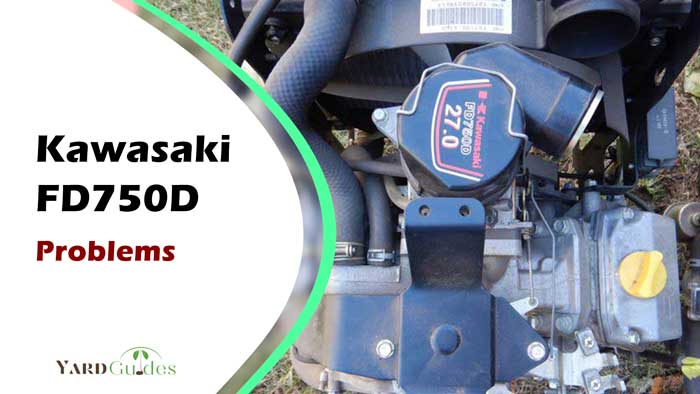The Kawasaki FD750D is one of the most popular engines used in various commercial and industrial applications. These applications include lawnmowers, power generators, construction machinery, and many more. But like other engines, it is reported with some common issues.
So, what are the Kawasaki FD750D problems? The common problems are associated with overheating, compression loss, electrical issues, compression loss, etc. However, all of these issues can be solved without much trouble.
This article will explore some of the most common issues users typically encounter with the Kawasaki FD750D engine. In addition, we will provide solutions and discuss how we can prevent these problems.
Problems With Kawasaki FD750D – Quick Solution Table
There are quite a few issues that Kawasaki FD750D users have to encounter. Here, we have made a table for a quick understanding of the details of these issues and their solutions.
| Problems | Solutions |
| Overheating Problems | Refill coolant |
| Clean the radiator | |
| Repair or replace thermostat | |
| Fix or install new water pump | |
| Refill or change engine oil if necessary | |
| Select a better location for proper engine ventilation | |
| Fuel System Issues | Clean the fuel filters |
| Repair the pump | |
| Replace carburetor | |
| Electrical Problems | Charge the battery |
| Fix and secure the wires | |
| Repair or replace alternator | |
| Compression Loss Problem | Replace worn components |
| Repair or replace head gasket |
4 Most Common Kawasaki FD750D Problems [Causes And Solutions]
Let’s break down the problems in detail and get their ways of solutions.
1. Overheating Problem
One of the most common issues that the engine faces are overheating problems. There are many a few reasons behind this issue that cause the engine to overheat. Check out the details of this issue here!
- Low Coolant Levels: If the coolant level is not up to the required level, the engine cannot regulate the temperature accurately, causing it to overheat.
- Clogged radiators: Clogged radiators due to debris or insects prevent the coolant from regulating properly.
- Faulty Thermostat: If the thermostat fails to perform properly, it will not circulate the coolant throughout the system, resulting in overheating.
- Water Pump Malfunction: Malfunctioned water pump can’t circulate the coolant resulting in overheating the engine.
- Other issues: Insufficient engine oil, loose or slipping fan belt, poor ventilation around the engine and carbon build-up in the combustion chamber are also the reasons behind overheating issues.
Solutions
- Check the coolant level in the engine regularly. Add more coolant and make sure that it is up to the required mark. Do not forget to use the right type of coolant for the engine.
- Examine the radiator and all the components connected to the cooling system. Clean all the dirt, debris, dust, etc., from the system. Lastly, look for any damaged or broken parts and repair or replace them if necessary.
- Make sure the thermostat is in proper working condition or not. If it is malfunctioning, repair it as necessary. You can also replace the thermostat with a new one if required.
- If the water pump is not working properly, it must be repaired for proper performance. In a few cases, you must replace the water pump entirely.
- Refill or change engine oil if necessary; select a better location for proper engine ventilation and call an authorized dealer for other issues to resolve.
2. Fuel System Problems
Fuel system problems include dirty filters, pump malfunctions, and so on.
- Dirty/Clogged Fuel Filter: Over time, the dirt, debris, etc., clogs the filters, which disrupts the flow of fuel into the engine.
- Fuel Pump Malfunction: It transfers gasoline from the fuel tank to the engine. But if the gasoline pump breaks, the engine will not operate properly.
- Carburetor Trouble: The carburetor is responsible for mixing air and fuel to create the proper ratio. If the carburetor fails, the engine will not work properly or fail to work completely.
Solutions
- Check and clean the dirty or clogged fuel filters regularly. If possible, replace the old filters with new ones after every 3 to 4 months, depending on the use of the vehicle.
- Examine the fuel pump and make sure it is in its optimum working condition. Repair the fuel pump if it is malfunctioning or replace it if necessary.
- Clean the carburetor to remove any pollutants or contaminants from the system. Rebuild the system to ensure it prepares the proper fuel-to-air ratio.
3. Electrical Problems
With so many wires and components connected to the system, many owners and users face electrical problems. Let us see the electrical issues that the Kawasaki FD750D engine encounters.
- Dead Battery: If the battery fails, the engine’s performance will suffer. In other instances, the engine will not operate at all.
- Wiring Issues: Several wires are connected to the engine to ensure the correct functioning of components. However, the wires often come loose or get damaged due to wear and tear. In cases like these, the components will fail to work properly.
- Malfunctioning Alternator: The work of an alternator is to charge the battery and power the electrical components. If the alternator is malfunctioning or faulty, the electrical components will not receive the required power to operate.
Solution
- Charge the battery according to the instructions from the manufacturers. You can also replace the battery with a new one to ensure proper operation and smooth performance.
- Examine the wires and ensure that they are connected properly. Secure the loose connections in place properly. Repair or replace the damaged wires and make sure that they are correctly connected to the system.
- Check the condition of the alternator and check if it’s working properly. Repair the system or replace it with a new one if required.
4. Compression Loss Issue
Last but not least, compression loss is a severe problem that Kawasaki users experience. Check out the causes of these issues and how they can be solved without much trouble.
- Worn Components: Piston rings and valves play very important roles when it comes to determining the proper performance of the engine.
However, the components undergo damage through wear or tear over time. This damage prevents the engine from functioning accurately.
- Damaged Head Gasket: The head gasket keeps the coolant and oil separate from combining. And the two fluids cannot be kept apart if the gasket is cracked or damaged. Moreover, this can lead to a loss in compression.
Solution
- Check out the condition of the valves and piston rings properly. Replace the worn components with new ones to ensure smooth engine operation.
- Inspect the head gasket and replace it with a new one. If the oil and coolant are mixed together, drain the fluids and refill properly.
Conclusion
The Kawasaki FD750D engine is one of the most reliable engine models available in the automobile industry. Many industrial and commercial users rely on this unit for its top-notch performance. However, the problems are nothing complex and can be fixed easily.
If you ever face any of the problems mentioned above, feel free to take help from this guide. You can solve the problems on your own if you have proper engine knowledge. Otherwise, you should call on a professional for the job.



